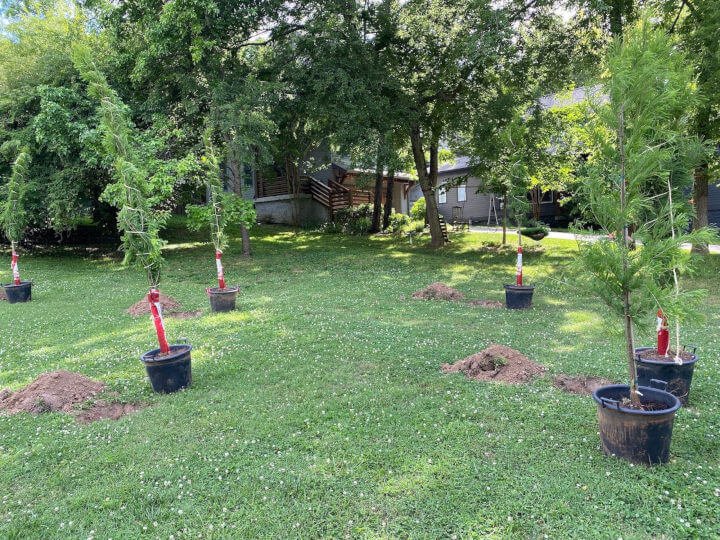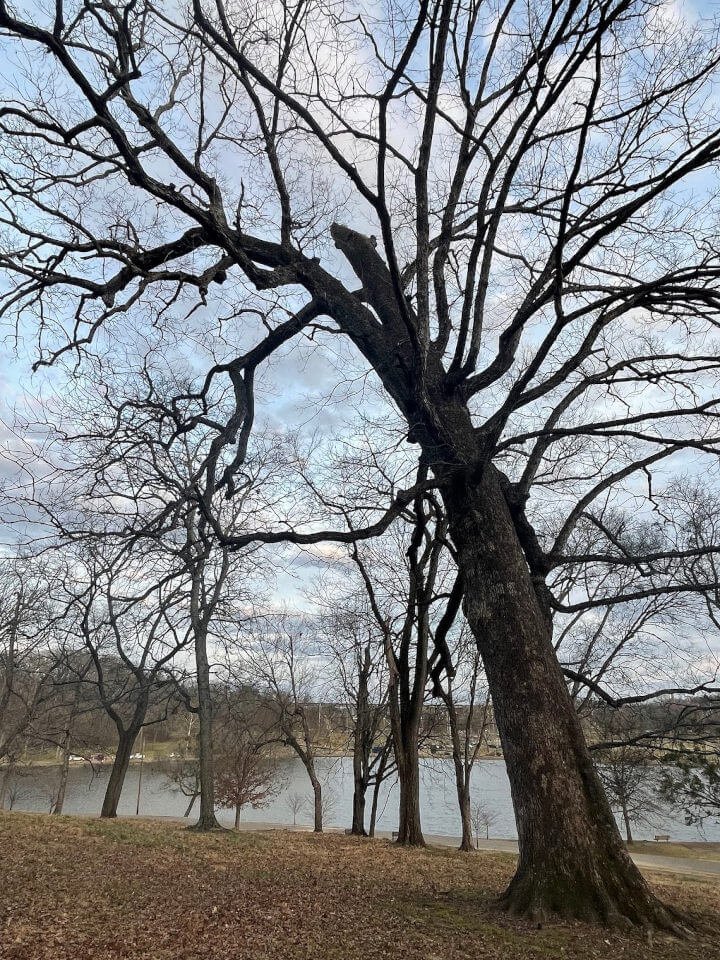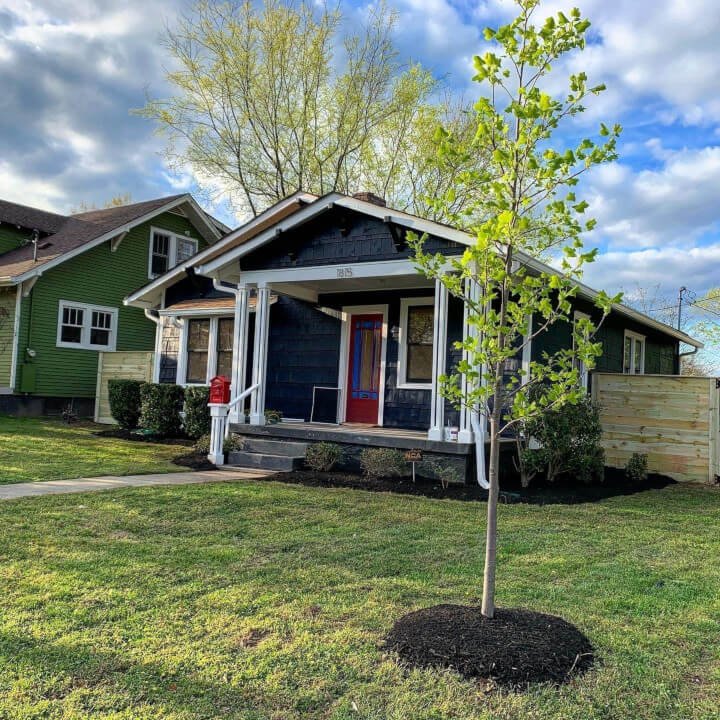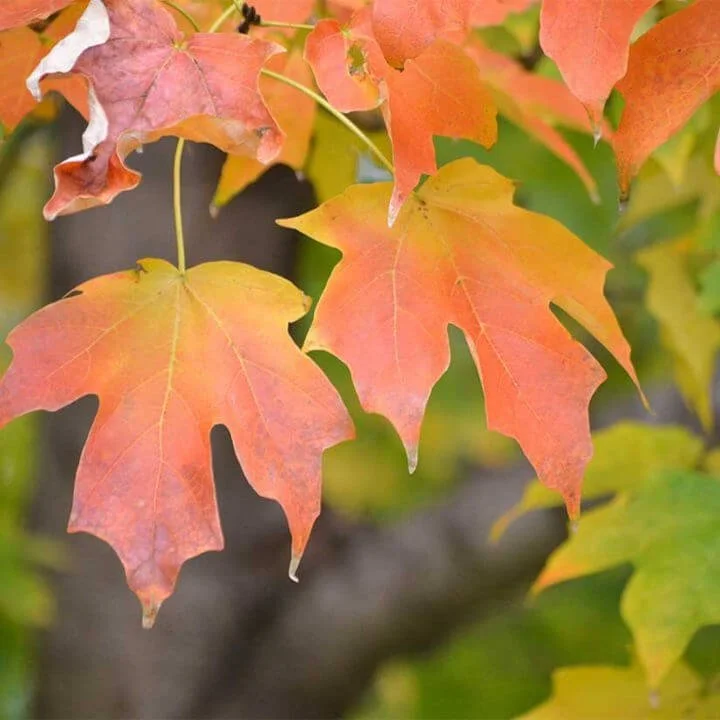Elm trees can be found across the northern hemisphere, and while many were decimated in the twentieth century by Dutch elm disease, elm tree varieties have since been bred by nurseries to be resistant to the disease. The Frontier elm is one such cultivar, and it’s prized not just for its resilience but also for its more compact size, urban hardiness, and beautiful burgundy foliage in the fall. Here, we’ll go over why this elm tree has become such a popular planting choice.
When spring arrives, we welcome the warm weather, but for some of us, pollen season can range from annoying to downright disruptive. However, pollen is half of the reproductive equation of a plant, and it’s the material that needs to be moved from flower to flower for plants to make seeds. Since pollen must be distributed for trees, flowers, grasses, and food crops, successful pollination is crucial for robust and livable environments.
There are many variations of the cherry trees that we can appreciate in different ways throughout the year. There’s no better time to take in the beauty of Nashville’s cherry blossoms than the month of April; the annual Nashville Cherry Blossom Festival will be held this year on Saturday, April 13th in Nashville Public Square Park. Visitors will be able to view many kinds of cherry trees in all their spring splendor!
While there are many shapes and sizes of cherry blossom trees, the most popular cultivar among them is the Yoshino cherry blossom—a medium-height tree with a stout crown that, for a few weeks in mid-spring, bursts into bloom with bunches of blushing white flowers. Here, we’ll go over this cultivar’s background, the conditions it thrives in, as well as some suggestions on where you can enjoy this tree’s spectacular display in Nashville this spring.
In the wake of spring winds and storms, residents with trees on their properties are likely going to find woody debris of all sizes. In this article, we provide some practical guidance on using fallen branches and other debris to help care for Nashville’s urban forest. Instead of just dragging the woody material to the curb for pickup, consider these garden-friendly ways to use tree debris!
Every tree that someone planted was a decision made, and the Shelby Avenue Arboretum is a project backed up with lots of heartfelt, thoughtful consideration that you can learn all about on its official website! At shelbyarboretum.org, residents and visitors of Nashville can read about how and why these trees were planted, curated, and chosen for specific themes; they can also find visual experiences and discover key ecological highlights about these trees. In this article, we’ll take a tour through the arboretum’s website as an introduction to this information-rich resource on these vibrant living exhibitions.
When seasons change, Nashville can reliably expect storms to arise from the fluctuations in temperature. The high winds that accompany rain, thunder, and lighting can have mild to devastating effects on the trees in our neighborhoods, from broken branches to whole fallen trees. While we can’t eliminate all risks, preventive maintenance routines can help homeowners avoid damage from weather events. Prepare for the unpredictable with our guide to safeguarding your trees and avoiding damage during Nashville’s stormy weather!
As one of the most common trees in North America, the red maple (Acer rubrum) can be seen in most places in the Eastern United States. The species is treasured as a robust shade tree that does well in neighborhoods and many urban settings. The tones of red on these maples add to their appeal, from the spring buds and flowers to fiery fall foliage. Here, we’ll go over the many reasons red maple trees thrive in Nashville and help Nashville thrive.
Between October 2023 and February 2024, the Nashville Tree Conservation Corps has delivered and planted 850 trees (and counting!) across Nashville through our annual tree sale! If you’d still like to purchase a tree this winter, we’re taking orders through mid-March, and any orders received afterward will be delivered in the fall.
Throughout the winter, trees continue to provide benefits despite being dormant, such as soil stability and habitat provision for wildlife. While fall brings vibrant colors after spring and summer’s greenery, being able to recognize trees in winter can add another layer of seasonal interest (that also builds your local tree knowledge) during the coldest months of the year.
Trees that we plant in our yards and along streets interact with our homes, our utility connections, local wildlife, and even us! Since trees in neighborhoods and urban locations are more isolated than those in nature, they need our help to keep them in good condition, good health, and safe from the dangers of the built environment. In this article, we’ll go over some of the main benefits, techniques, and best practices to help your Nashville trees thrive.
The founder of Nashville Tree Conservation Corps, Jim Gregory, is stepping back from his position as executive director, remaining with the organization in an advisory role. Without him, NTCC would not be making the impact it is today, so we thank him for his important work! We’re looking forward to continuing to collaborate with Jim, but due to his departure, we have new leadership!
Natchez crape myrtle trees are among the most popular ornamental trees in the Southern US, and these distinctive and distinguished trees can be found in gardens across Nashville. Crape myrtles are beloved for their compact size, sprayed shape, and tufts of fluffy flowers, and the Natchez variety is a favorite choice for its hardy nature and bright, white blooms. Here, we’ll go over why it’s so widespread.
It can be easy to take trees for granted; they’re in the background of everyday life, and big, mature trees are there for so many years that they seem like a given. However, anyone who has planted a sapling, maintained the trees in their yard, or dealt with a weak or aging tree knows that it’s a big responsibility!
Trees provide many ecosystem benefits in every season of the year! Read on to learn how trees help maintain our environments during winter.
An evergreen conifer native to the eastern half of North America, the eastern red cedar is a bushy tree that provides ecological benefits year-round. It’s a cold-hardy tree that is adaptable to a variety of soil types, loves full sun, and can tolerate salt and pollution, making it an outstanding urban tree and a particularly powerful contribution to any type of landscape.
The bald cypress (Taxodium distichum) is a unique canopy tree that offers serious environmental benefits while also having an interesting visual appeal that is its own. This tree is a moisture-loving conifer with feathery leaves that drop off in the winter. Between its form and function, the bald cypress is a robust contribution to a property’s landscape and a neighborhood’s canopy.
Planting a tree may require more forethought than you think! There are lots of things to take into consideration when choosing the location for a sapling, including its purpose, maintenance needs, your yard’s soil type, and in particular, the mature size of the tree. Big trees shouldn’t be planted too close since they can become hazards to people and property if they grow to full size in the wrong spot, while small trees can be planted closer to a house with fewer issues.
While Nashville’s neighborhood canopy offers a colorful backdrop to everyday life in autumn, there are many majestic displays of nature’s beauty just outside of Nashville! Whether it’s an outing with family and friends or time to commune with nature on your own, getting into wild spaces is one of the best ways to truly appreciate and enjoy the vibrant fall foliage, wildlife, and many outdoor activities made available by protected areas. Here, we’ll go over seven destination locations near Nashville where you can take a break from town life and immerse yourself in the shades of the season.
Careful curation of a property’s landscape is essential to prevent invasive species from being introduced into local areas by spreading from yards into unmanaged and wild environments. In this article, we’ll go over what invasive plants are, how they spread, what negative effects they can have on ecosystems and human communities, as well as how to get rid of them, prevent their establishment, and manage the spread of those invasives already present.
A hybrid of two types of sycamore trees, the London plane was popularized in and originally distributed from its namesake city, being an urban tree through and through. Its robust and hardy nature makes this tree a great choice for Nashville streets and neighborhoods, where a London plane will thrive in the built environment.
As sweater weather settles in, so do the reds, yellows, and oranges of fall leaves in Nashville. The canopy’s color change creates the annual show that reminds us of the year’s progress, giving us a bright visual treat before the more somber season of winter takes hold. In Nashville, where warmer temperatures linger into October, mid-fall is when leaf color change is at its peak.
From an acorn to a robust, mighty tree, the oak is often used as a symbol of patience and durability. Oaks are well-known for their sturdy trunks, distinctive acorns, and lobed leaves, as well as their longevity. In this article, we’ll profile some of the different kinds of oak trees that can be found around Nashville.
Anthracnose is the common name for a group of fungal pathogens that grow on the leaves and branches of trees of all kinds. While the fungus is unsightly, it isn’t deadly in most cases and usually clears up on its own. Here, we’ll go over how to spot anthracnose, how it affects trees, and what you can do to reduce the chances of it taking hold in the early months of spring.
Scale (also called bark scale) is a common pest found on both indoor and outdoor plants, including trees. While not all are specialized, some scale bugs are associated with specific plants and trees. Any tree can be affected by scale, but over the last several years, there has been a particular problem with a newly invasive scale bug being found on crepe myrtle trees. Here, we’ll go over what scale is, why these bugs are a problem, and how to deal with them if you find a tree infested with them.
The emerald ash borer (EAB) has had a serious effect on Nashville’s ash trees over the last several years since the invasive beetle was first spotted in Davidson County in 2014. This year, in 2023, it has become more apparent how devastating that effect has been. Although some precautions can be taken to manage surviving trees, the emerald ash borer’s damage is real and ongoing.
One of the more common tree diseases you might see on your oak, sycamore, or elm is bacterial leaf scorch. The symptoms of this infection are most noticeable towards the end of summer and beginning of fall throughout the southern and eastern US, and it may be mistaken for a lack of water because it shows up on the leaves of infected trees as crispy, brown edges. This is because the bacteria affects the tree’s ability to process water, which starves the extremities. Here, we’ll go over how bacterial leaf scorch is spread, how to identify it, and what can be done to control an infection.
Maple trees are loved for many reasons: their bushy canopies provide lots of shade in the summer, they are sturdy trees, and their iconic leaves offer a show in a range of colors throughout autumn. However, a maple isn’t just a maple! There are many varieties of maple trees out there, each with a distinctive character. Here, we’ll profile some of the most common species of maple that you may find across Nashville.
One of the most beloved and common trees in Tennessee is the tulip poplar—so much so that it is the state tree! This poplar is so popular, in fact, that it’s the State tree for two others: Kentucky and Indiana.

Fine-tuning the Nashville Tree Bank
Did you know that Nashville has a Tree Bank, an account with funds used to plant trees on public properties? Unless you’re a commercial developer or a tree advocate (like us!) you’re probably unaware that such an account exists — much less how it operates. Since Metro’s new tree ordinance took effect on September 1, 2019, city officials have reworked procedures for the Tree Bank, trying to bring more transparency and accountability to the process.
The new tree ordinance, sponsored by Council Member Angie Henderson and passed in July, increased the tree density requirements for commercial and multifamily projects (offices, retail spaces, apartments and condos). It was the first new tree law in Metro Nashville in more than 10 years. Under existing law, developments that can’t plant enough trees to meet the legal standards for tree density must deposit funds in the Tree Bank.
“If we were going to elevate the tree density requirements, we needed to show the builder community that this was a formalized process.”
“The Tree Bank was a little bit mysterious,” Henderson says of the account’s handling in the past. “If we were going to elevate the tree density requirements, we needed to show the builder community that this was a formalized process. It’s not that it was mismanaged or used incorrectly, but that it really wasn’t tracked or organized.”
Before the new law, the Tree Bank was controlled by Metro Parks and Recreation, with horticulturalist Randall Lantz deciding when and how to use funds to plant trees at Metro parks. Under the new system, the Tree Bank can be used to plant trees on any city property, including schools and rights-of-way. Applications for planting will be reviewed by the Tree Working Group (which includes tree-related staff from Parks, Public Works, Water Services, General Services, Codes and Planning).
Metro Water Services will control disbursal of the funds. Much of Nashville’s tree policy is now centered in Water Services, “a logical, supportable nexus since trees are stormwater infrastructure,” Henderson says.
As before, Nashville’s urban forester, Stephan Kivett, will determine which developments are eligible for fee-in-lieu payments to the Tree Bank, and how much is owed. The fees are based on a sliding scale, mandated by a 2008 Council Resolution. For 1 to 99 Tree Density Units (TDUs), developers must pay $725 per TDU into the Tree Bank. The city’s goal is to plant at least two new trees on public property for each TDU payment collected, and every tree planted will be recorded and tracked in Metro’s Tree Keeper software.
The Tree Bank received one payment of $2,392.50 in 2019 after the new ordinance was passed. “It is too early to determine how much will be deposited under the new system,” says Rebecca Dohn, environmental compliance officer at Metro Water Services. “But we expect it to be more than was previously collected. “
Henderson says the Tree Bank funds are not “huge” because exemptions are rarely granted. “We want people to plant the trees they’re required to plant” whenever possible, rather than make payments to the Tree Bank. Poor soil for trees and limitations of historic buildings on small sites are two factors that could support an exemption.































Creating awareness about canopy care is one of the most important ways to keep our city green! To help spread the message, the Nashville Tree Conservation Corps team will have a booth at two events in April 2024: Nashville’s Earth Day festival on Saturday, April 20th, and Honeytree Meadery’s Arbor Day celebration on Sunday, April 28th. Come have a conversation with us and join your Nashville neighbors in honoring our environment and its produce!